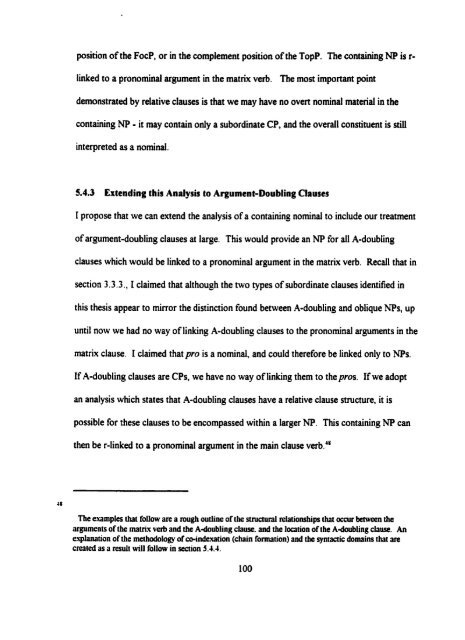Adverbial and Argument-Doubling Clauses in Cree - MSpace
Adverbial and Argument-Doubling Clauses in Cree - MSpace
Adverbial and Argument-Doubling Clauses in Cree - MSpace
Create successful ePaper yourself
Turn your PDF publications into a flip-book with our unique Google optimized e-Paper software.
position of the FocP, or <strong>in</strong> the complement position of the TopP. The conta<strong>in</strong><strong>in</strong>g NP is r-<br />
l<strong>in</strong>ked to a pronom<strong>in</strong>al argument <strong>in</strong> the matrix verb. The most important po<strong>in</strong>t<br />
demonstrated by relative clauses is that we may have no overt nom<strong>in</strong>al material <strong>in</strong> the<br />
conta<strong>in</strong><strong>in</strong>g NP - it may conta<strong>in</strong> only a subord<strong>in</strong>ate CP, <strong>and</strong> the overall constituent is still<br />
<strong>in</strong>terpreted as a nom<strong>in</strong>al.<br />
5.4.3 Extend<strong>in</strong>g this Analysis to <strong>Argument</strong>-<strong>Doubl<strong>in</strong>g</strong> CIauses<br />
1 propose that we can extend the analysis of a conta<strong>in</strong><strong>in</strong>g nom<strong>in</strong>al to <strong>in</strong>clude our treatment<br />
of argument-doubl<strong>in</strong>g clauses ai large. This would provide an NP for al1 A-doubl<strong>in</strong>g<br />
clauses which would be I<strong>in</strong>ked to a pronom<strong>in</strong>al argument <strong>in</strong> the matrix verb. Recail that <strong>in</strong><br />
section 3.3 -3., I clairned that although the two types of subord<strong>in</strong>ate clauses identified <strong>in</strong><br />
this thesis appear to mirror the dist<strong>in</strong>ction found between A-doubl<strong>in</strong>g <strong>and</strong> oblique NPs, up<br />
until now we had no way of l<strong>in</strong>k<strong>in</strong>g A-doubl<strong>in</strong>g clauses to the pronom<strong>in</strong>al arguments <strong>in</strong> the<br />
matrix clause. 1 claimed that pro is a nom<strong>in</strong>al, <strong>and</strong> could therefore be l<strong>in</strong>ked only to NPs.<br />
If A-doubl<strong>in</strong>g clauses are CPs, we have no way of l<strong>in</strong>k<strong>in</strong>g them to the pros. If we adopt<br />
an analysis which states that A-doubl<strong>in</strong>g clauses have a relative clause structure, it is<br />
possible for these clauses to be encompassed with<strong>in</strong> a larger NP. This conta<strong>in</strong><strong>in</strong>g NP can<br />
then be r-l<strong>in</strong>ked to a pronom<strong>in</strong>al argument <strong>in</strong> the ma<strong>in</strong> clause verb."<br />
The examples chat follow are a rough outi<strong>in</strong>e of the structural relationships thrit accur ktween the<br />
arguments of the mulx verb <strong>and</strong> the Adoubl<strong>in</strong>g clause. <strong>and</strong> the location of the Adoubl<strong>in</strong>g clause. An<br />
e.xplanation of the methodology of co-<strong>in</strong>de'mtion (chah formation) <strong>and</strong> the syntactic doma<strong>in</strong>s that are<br />
created as a result will follow <strong>in</strong> section 5.4.).








![an unusual bacterial isolate from in partial fulf]lment for the ... - MSpace](https://img.yumpu.com/21942008/1/190x245/an-unusual-bacterial-isolate-from-in-partial-fulflment-for-the-mspace.jpg?quality=85)




![in partial fulfil]ment of the - MSpace - University of Manitoba](https://img.yumpu.com/21941988/1/190x245/in-partial-fulfilment-of-the-mspace-university-of-manitoba.jpg?quality=85)


